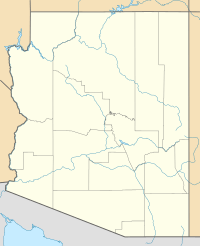Peacock Mountains facts for kids
Quick facts for kids Peacock Mountains |
|
|---|---|
| Highest point | |
| Peak | Peacock Peak (Arizona) (center of range, ridgeline to north) |
| Elevation | 6,293 ft (1,918 m) |
| Dimensions | |
| Length | 26 mi (42 km) N-S |
| Width | 10 mi (16 km) (about 14-mi at south) |
| Geography | |
| Country | United States |
| Communities | Valle Vista, (Hackberry) and (Kingman) |
| Range coordinates | 35°18′16″N 113°46′22″W / 35.3044°N 113.7727°W |
The Peacock Mountains are a mountain range in northwest Arizona, USA. This range is about 26 miles (42 km) long. It is a smaller part of the Hualapai Mountains area, located to its northeast. The Peacock Mountains are bordered by the Hualapai Valley to the northwest. On its east side, there are washes and cliffs, like the Cottonwood Cliffs.
Contents
Exploring the Peacock Mountains
The Peacock Mountains are a smaller range with lower elevations. They are about 10 miles (16 km) wide. The highest point is Peacock Peak (Arizona), which stands at 6,293 feet (1,918 meters) tall. This peak is near the center of the range. From there, a ridge goes north for about 13 miles.
At the northern end of the mountains, you can find Arizona State Route 66. This famous road goes around the range from northeast to southeast. To the north are the Grand Wash Cliffs. The Hualapai Valley also stretches from the northern end.
Water Flow and Valleys
The eastern side of the Peacock Mountains has streams that flow north and south. These streams are on the west side of the Cottonwood Cliffs. In the middle of the mountain range, there is a "water divide." This means water flows in different directions from this point.
From this divide, Hackberry Wash flows north. It joins Truxton Wash, which comes from the northeast. Truxton Wash then turns northwest at the base of the Peacock Mountains. It flows into the southeastern part of the Hualapai Valley.
To the southeast of the mountains, Knight Creek begins. This creek flows south. About 25 miles from the water divide, Knight Creek becomes the Big Sandy River. The southern part of the Peacock Mountains is wider, about 14 miles across. Many smaller washes from the mountains feed into Knight Creek.
Plants and Nature
The Peacock Mountains are a special place where five different types of plant communities meet.
- Mojave Desertscrub: This type of desert plant life is found to the northwest, west, and southwest of the mountains. It also reaches into the Grand Canyon area.
- Sonoran Desert-scrub: To the south, you'll find the northern edge of the Sonoran Desert plants. These grow along the Big Sandy River.
- Semidesert Grassland: This grassland is common in southeastern Arizona. However, it also stretches northwest into the valleys and mountains of the Arizona transition zone. It reaches the Big Sandy River and the Sacramento Valley.
Higher Elevation Plants
Two other plant communities are found at higher elevations near the Peacock Mountains.
- Plains and Great Basin Grassland: You can see this grassland along Truxton Wash to the northeast. Further east, on the Hualapai Indian Reservation and Aubrey Valley areas, there is a large area of this grassland.
- Great Basin Conifer Woodland: This woodland is mixed with the grassland. Together, these two communities cover most of northern Arizona. They are found everywhere except for specific desert areas or very high mountain peaks.



